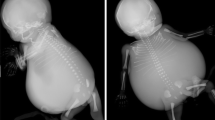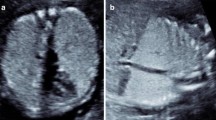Abstract
Background
Congenital high airway obstruction syndrome (CHAOS) is a rare disorder defined as any fetal abnormality that obstructs the larynx or trachea. Prompt airway intervention at delivery after accurate prenatal diagnosis may allow survival of this otherwise fatal condition.
Objective
To identify prenatal MRI findings in CHAOS, to compare these findings with those of fetal US, to determine if imaging alters diagnosis and management decisions, and to correlate prenatal with postnatal imaging findings.
Materials and methods
Records and MRI scans of ten fetuses with CHAOS were reviewed, and the findings correlated with outside and same-day fetal US and postnatal imaging findings. Fetal lung volumes were measured on MRI scans.
Results
Large lung volumes were found in 90% of the fetuses. Increased lung signal intensity, inverted diaphragm, and a dilated, fluid-filled lower airway were identified in all. The obstruction level was identified in 90%. MRI changed screening US diagnosis in 70%, but was concordant with the tertiary care US imaging in 90%. Seven fetuses were terminated or died in utero, and three fetuses survived after ex utero intrapartum tracheostomy placement. Autopsy or bronchoscopy performed in 60% confirmed CHAOS. Postnatal chest radiographs and CT showed hyperinflation, while US and fluoroscopy showed diminished diaphragmatic motion.
Conclusion
MRI demonstrates large lung volumes, increased lung signal intensity, inverted diaphragm, and dilated fluid-filled lower airway, and usually identifies the obstruction level. The degree of correlation between MRI and tertiary prenatal US is high, but CHAOS is frequently misdiagnosed on screening US. Correct diagnosis may enable planned airway management. Voluminous lungs and diaphragmatic abnormalities persist on postnatal imaging.





Similar content being viewed by others
References
Rypens F, Metens T, Rocourt N et al (2001) Fetal lung volume: estimation at MR imaging – initial results. Radiology 219:236–241
Tewfik TL, Sobol SE (2006) Congenital malformations, larynx. eMedicine. http://www.emedicine.com/ent/topic324.htm. Accessed 24 July 2008
Manoukian JJ, Tan AK (1997) Embryology of the larynx. In: Tewfik TL, Der Kaloustian VM (eds) Congenital anomalies of the ear, nose, and throat. Oxford University Press, New York, pp 377–382
O’Rahilly R, Muller F (1992) Human embryology and teratology. Wiley-Liss, New York, pp 183–192
Hooper SB, Harding R (1995) Fetal lung liquid: a major determinant of the growth and functional development of the fetal lung. Clin Exp Pharmacol Physiol 22:235–247
Harding R, Hooper SB (1996) Regulation of lung expansion and lung growth before birth. J Appl Physiol 81:209–224
Harding R, Bocking AD, Sigger JN (1986) Influence of upper respiratory tract on liquid flow to and from fetal lungs. J Appl Physiol 61:68–74
Vilos GA, Liggins GC (1982) Intrathoracic pressures in fetal sheep. J Dev Physiol 4:247–256
Clewlow F, Dawes GS, Johnston BM et al (1983) Changes in breathing, electrocortical and muscle activity in unanesthetized fetal lambs with age. J Physiol 341:463–476
Harding R, Bocking AD, Sigger JN (1986) Upper airway resistances in fetal sheep: the influence of breathing activity. J Appl Physiol 60:160–165
Dickson KA, Maloney JE, Berger PJ (1987) State-related changes in lung liquid secretion and tracheal flow rate in fetal lambs. J Appl Physiol 62:34–38
Harding R, Hooper SB, Han VK (1993) Abolition of fetal breathing movements by spinal cord transection leads to reductions in fetal lung liquid volume, lung growth, and IGF-II gene expression. Pediatr Res 34:148–153
Nardo L, Hooper SB, Harding R (1998) Stimulation of lung growth by tracheal obstruction in fetal sheep: relation to luminal pressure and lung liquid volume. Pediatr Res 43:184–190
Grethel EJ, Nobuhara KK (2006) Fetal surgery for congenital diaphragmatic hernia. J Paediatr Child Health 42:79–85
Rice HE, Estes JM, Hedrick MH et al (1994) Congenital cystic adenomatoid malformation: a sheep model of fetal hydrops. J Pediatr Surg 29:692–696
Lim FY, Crombleholme TM, Hedrick HL et al (2003) Congenital high airway obstruction syndrome: natural history and management. J Pediatr Surg 38:940–945
Kuwashima S, Kitajima K, Kaji Y et al (2008) MR imaging appearance of laryngeal atresia (congenital high airway obstruction syndrome): unique course in a fetus. Pediatr Radiol 38:344–347
Fraser G (1962) Our genetic load. A review of some aspects of genetic variation. Ann Hum Genet 25:387–415
Slavotinek AM, Tifft CJ (2002) Fraser syndrome and cryptophthalmos: review of the diagnostic criteria and evidence for phenotypic modules in complex malformation syndromes. J Med Genet 39:623–633
Kalache K, Chaoui R, Tennstedt C et al (1997) Prenatal diagnosis of laryngeal atresia. Prenat Diagn 17:577–581
Shimabukuro F, Sakumoto K, Masamoto H et al (2007) A case report of congenital high airway obstruction syndrome managed by ex utero intrapartum treatment: case report and review of the literature. Am J Perinatol 24:197–202
Coakley FV, Hricak H, Filly RA et al (1999) Complex fetal disorders. Effect of MR imaging on management – preliminary clinical experience. Radiology 213:691–696
Walker P, Cassey J, O’Callaghan S (2005) Management of antenatally detected fetal airway obstruction. Int J Pediatr Otorhinolaryngol 69:805–809
Kohl T, Hering R, Bauriedel G et al (2006) Fetoscopic and ultrasound-guided decompression of the fetal trachea in a human fetus with Fraser syndrome and congenital high airway obstruction syndrome (CHAOS) from laryngeal atresia. Ultrasound Obstet Gynecol 27:84–88
Author information
Authors and Affiliations
Corresponding author
Rights and permissions
About this article
Cite this article
Mong, A., Johnson, A.M., Kramer, S.S. et al. Congenital high airway obstruction syndrome: MR/US findings, effect on management, and outcome. Pediatr Radiol 38, 1171–1179 (2008). https://doi.org/10.1007/s00247-008-0962-2
Received:
Revised:
Accepted:
Published:
Issue Date:
DOI: https://doi.org/10.1007/s00247-008-0962-2




